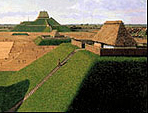| 
It is clear that organizational control was a vital part of Cahokia
society. Archaeologist Timothy R. Pauketat supports the view that
the Cahokia public works were more than symbols of religious beliefs
in the powers of the cosmos: "Cahokian monuments it seems, to
be monuments, required the regular mobilization of community labor,
no doubt a means of perpetuating both elite control of community
labor and the common perception that elite caretakers were necessary
for the very existence of the community."
Archaeologist Rinita Dalan continues the argument persuasively:
Delayed returns associated with agriculture necessitate
the establishment of a stable and cooperative labor pool....The
communal construction and use of mounds, plazas and other earthen
features would have provided a means of creating and perpetuating
social relations, and establishing and maintaining the labor force
necessary for large-scale agricultural pursuits. The durability
of this construction and its attendant message of group permanence
would have assured a commitment to place and to the transformation,
both social and ecological, of the landscape....
Monks Mound and the Grand Plaza were clearly critical in the
definition and creation of a large integrated community...simultaneously
emphasizing the importance of the ruling hierarchy and the masses.
The large, accessible plaza, which appears to have been capable
of accommodating the resident population and more, provided
a centralized location for ritual activities and served as a
collective representation of the group. In contrast, the mounds
represented an intricate system in which the relationships of
different community and polity groups were ordered. The power
of the chief was manifested in a mound that stood above all
others. The power of the center was expressed in the profusion
of its mounds.
In this way powerful chiefs and their affiliated ruling class could
perpetuate their control and position. By associating themselves
with the power of the sky they provided celestial legitimacy for
their status, and by erecting a monumental city around them they
perpetuated the belief system and their own place at the top of
the social, religious, and political hierarchy. In addition, the
system ensured public safety.
In other words, the chief at Cahokia appropriated the celestial
cosmology that ordered the religious beliefs of his people to strengthen
the social hierarchy he headed. Melvin L. Fowler summed it up well:
The creation of a sacred landscape is accomplished
through the building of monumental constructions within, or near,
a specific community. These sacred landscapes serve as the focal
point of ceremonies in the ritual calendar in which "chiefs acted
as gods on earth connected to cosmic forces."
The astronomical connotations of woodhenges and other constructions
at Cahokia belong to the vocabulary of consolidated political
power during the decades preceding Cahokia's Emergent Mississippian
era. Because authority in this community was always in contention,
the community was stabilized through the use of symbols which
legitimized the status of the elite. The construction of mounds,
post circles, and plazas consumed labor on a massive scale.
Through civic construction, Cahokia's elite created highly visible
expressions of the power that mobilized that labor in the first
place. These displayed the social structure of Cahokia with
daily reminders that no one residing in the city, or visiting
it, could ignore, for they defined the geographical, social
and political landscape with architectural spectacle....
The greater Cahokia site...relates the hierarchy of the social
structure to the architecture of the cosmos. Through mythical
ancestors and celestial divinities, the elite allied themselves
with the power of the sky. Plazas located at the cardinal directions
link the architecture of Cahokia to the architecture of the
heavens, providing celestial legitimacy for social stratification
and elite ranking. The plan of Cahokia is a portrait of Cahokia
society.
...A complex community like Cahokia establishes its territorial
claims and prerogatives, then, by operating symbolically as
a miniaturization of the cosmos, it conforms itself with the
topographical features of the sacred landscape by making its
layout a template of cosmic order. This usually means that celestial
events, which reveal cosmic order, are in one way or another
incorporated into the design. Cardinal orientation, seasonal
solar alignment, and calendric ritual all may play a role.
We have seen the cosmological legacy the Mississippians inherited
from their predecessors — for example, the solar calendar
at Poverty Point — and we know there are historical analogues
of their beliefs in the Amerindian tribes that came after them.
The interpretation of Cahokia as a symbolic microcosm seems reasonable
at this stage of our understanding.
|
|
Excerpted from pages 51-65 of Cahokia: Mirror of the Cosmos by Sally A. Kitt Chappell, published by the University of Chicago Press. Copyright 2002 The University of Chicago
|
|
«
previous
8 of 8
|
 |

|
 |


Figure
#4: Cahokia Rendering (Lloyd K. Townsend) »
| M
O R E |
| Learn
more about Cahokia
in Bringing the Heavens to Earth. |
|
|
|